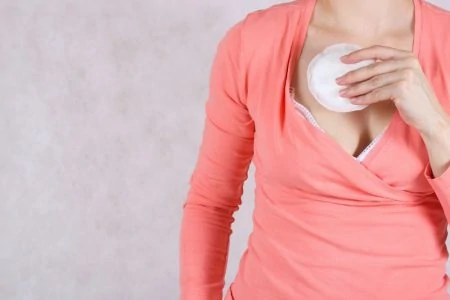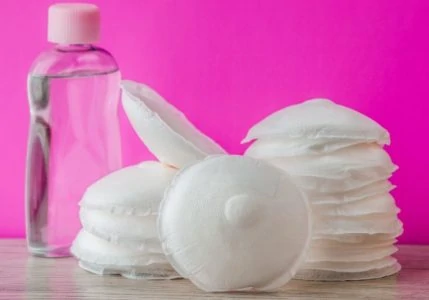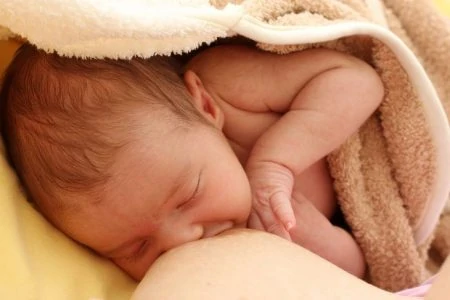If you are pregnant or nursing, you have likely already discovered one of the messy realities of motherhood: milk leakage. Unexpected let-downs are incredibly common, but they can be embarrassing if you are out in public unprepared.
Breast pads, often called “nursing pads,” are absorbent liners that sit between your nipple and your bra. They act as a shield to protect your clothes from milk leaks, wet spots, and stains.
We have been there, done that, and dealt with the wet shirts. To help you stay dry and comfortable, we are breaking down the differences between disposable and reusable pads. Here is the lowdown on how to use them correctly for maximum protection.
Key Takeaways
- Purpose: Pads are most useful in late pregnancy and early breastfeeding when your milk supply is regulating and surprise let-downs are frequent.
- Hygiene: While safe, pads must be changed frequently to prevent bacterial growth and fungal infections like thrush.
- Types: You can choose between disposables (convenient but ongoing cost) or reusables (eco-friendly but require washing).
- Care: Reusable pads need specific washing routines, often hot water and heavy drying, to eliminate yeast and bacteria.
Why You Need Breast Pads
During the final weeks of pregnancy and the first few months of nursing, your body works overtime to perfect the process of making sufficient milk. Before you and your baby settle into a predictable routine, your breasts will likely release milk without warning (1).
Even after your supply regulates, leaks can happen. Let-downs are triggered by more than just a physical need to empty the breast; emotions play a huge role. Simply hearing a baby cry, looking at a photo of your little one, or even yearning for a snuggle can trigger a release of milk.
The Benefits
Are They Safe?
It is natural to worry about hygiene when placing something against your skin all day, especially near where your baby feeds. The good news is that breast pads are safe and hygienic when used correctly.
However, you need to remain diligent.
Remember
Change your pads the moment they feel damp. Constant moisture against the nipple fosters bacterial growth, which is risky if you have cracked skin. Unresolved nipple pain or infection can result in mastitis, a painful infection of the milk duct (2).
Moisture also encourages fungal growth. Candida is a yeast that causes thrush, a common issue for nursing moms. Thrush can spread between the baby’s mouth and the mother’s nipple, causing itching, burning, and flaky rashes (3).
If you use reusable pads and develop thrush, be careful. Yeast can live in the fabric even after a standard wash cycle. You will need to wash pads in hot water with bleach and dry them on high heat to prevent reinfection (4).
Lastly, some materials may irritate sensitive skin. If this happens, try a different brand or material, and use nipple creams to create a protective barrier.
Breast Pad Options
There are two main categories of breast pads. The right choice depends on your lifestyle, budget, and flow.
Disposable Pads
These are single-use, absorbent liners, similar in concept to sanitary napkins. They are generally thinner and often come individually wrapped.
Benefits:
- Convenient for travel.
- Hygienic (toss after use).
- Adhesive backing keeps them in place.
- Plastic lining prevents leak-throughs.
- Thin and discreet under shirts.
Drawbacks:
- Not eco-friendly (creates waste).
- Plastic backing reduces breathability.
- Ongoing monthly expense.
Reusable Pads
These are washable cloth pads made from cotton, bamboo, or wool. They are designed to be washed and worn repeatedly.
Benefits:
- Eco-friendly and sustainable.
- Cost-effective over time.
- Softer and more breathable fabrics.
Drawbacks:
- Thicker and potentially visible under tight clothes.
- Higher upfront cost.
- Requires regular laundry.
- You need a stash of 10, 12 pairs.
- Usually lack adhesive backing.
How To Use Disposable Breast Pads
1. Prep Your Skin
Start with a dry nipple to prevent trapping moisture against the skin. If you are sore, apply a thin layer of nipple cream first.
2. Peel the Backing
With clean hands, remove the pad from the wrapper. If your brand has adhesive strips, peel off the paper backing.
3. Center the Pad
Place the center of the pad directly over your nipple. This ensures maximum absorbency where the flow hits.
4. Secure to Bra
Press the adhesive side firmly into the cup of your bra. Put your bra on and adjust the pad if it shifted during the process.
5. Toss When Damp
Check the pad regularly. Once it feels moist, throw it away immediately to prevent irritation or infection. Never reuse a disposable pad.
6. Release Gently
If a pad gets stuck to a dried nipple, do not rip it off. Apply a little water to loosen the fibers, then gently peel it away. This protects cracked nipples from further damage.
How To Use Reusable Breast Pads
1. Check for Dryness
Ensure your reusable pad is 100% dry from the laundry before using it. Damp fabric is a haven for bacteria.
2. Prep the Nipple
Make sure your nipple is clean and dry. Apply cream if necessary to soothe irritation.
3. Place in Bra
Since reusables rarely have adhesive, place the pad inside your bra cup and pull the bra up to hold it in place. Ensure it is wedged securely between the breast and the fabric.
4. Adjust for Visibility
Reusable pads are thicker. You may need to adjust the positioning or wear a lightly padded bra to smooth out the silhouette.
5. Store Used Pads
When the pad gets wet, remove it. If you are out, store used pads in a waterproof “wet bag” or a zip-top bag until you get home. Do not let them sit in the laundry hamper wet for days.
6. Wash Correctly
Follow the manufacturer’s instructions. Cotton, bamboo, and wool all have different requirements regarding temperature and detergents.
- Check the label: Some require hot water, while others (like wool) might shrink.
- Skip the softener: Never use fabric softener or dryer sheets. They coat the fibers and drastically reduce absorbency.
7. Disinfect After Thrush
If you are treating a yeast infection, normal washing is not enough. To kill the yeast:
- Switch to disposables temporarily for 2, 4 weeks while treating the infection.
- Wash pads in hot water with 1 cup of vinegar.
- Add a sanitation aid like bleach (if fabric safe), tea tree oil, or grapefruit seed extract to the wash.
- Dry the pads in direct sunlight, which helps kill lingering yeast.
FAQs
The Bottom Line
Milk leakage is a messy but normal part of the breastfeeding journey. Nursing pads are your best defense against stains and public embarrassment.
Whether you opt for the convenience of disposables or the comfort of reusables, the rule remains the same: keep it dry. Change your pads regularly to keep your skin healthy and your feeding journey smooth.











